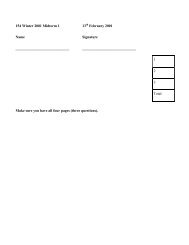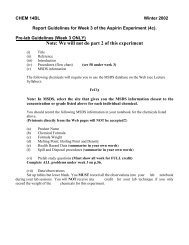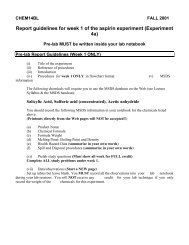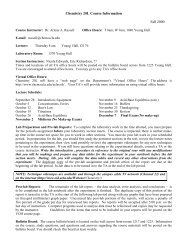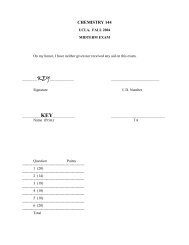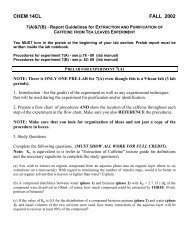Create successful ePaper yourself
Turn your PDF publications into a flip-book with our unique Google optimized e-Paper software.
Chemistry 30AL Final Exam Review and Study Questions<br />
Answer Key<br />
1. Explain why the melting point of a crude product is lower than the melting point<br />
of the product after recrystallization.<br />
Answer:<br />
Recrystallization purifies the product. Since the mole fraction of the impurity is<br />
now smaller, there is less freezing point depression than in the crude product.<br />
2. What observations would have differed in your ion exchange column experiment<br />
if you had reversed the order of elution of the acid concentrations?<br />
Answer:<br />
You would obtain no separation. All the ions would be washed off the column at the<br />
same time by the dilute HCl solution.<br />
3. The stoichiometric equation for the aldol condensation of benzaldehyde with acetone<br />
is given below.<br />
2<br />
MW: 102g/mol 58g/mol 234g/mol<br />
(a) (If a reaction of 1.00 mL of benzaldehyde (density = 1.0415 g/mL) is reacted with<br />
0.360 mL of acetone (density =0.7899 g/mL), what is the theoretical yield (in grams)<br />
of product?<br />
Answer:<br />
Acetone is the limiting reagent with 0.00498 mol<br />
0.00498 mol of acetone will theoretically produce 1.15g of product<br />
(b) If the actual experimental yield for the reaction was 89%, how many mL of acetone<br />
would be required to produce 4.00 grams of product?<br />
Answer:<br />
1.41 mL<br />
O<br />
H<br />
+<br />
O<br />
NaOH/H 2O<br />
C 2H 5OH<br />
4. Ammonia, NH 3, forms complex ions with many metals. Like the iron oxalate<br />
compound that you prepared this quarter, a variable number of the ammonia<br />
ligands can replace water ligands on these metals. The general formula for a<br />
nickel(II) chloride compound complexed with ammonia is<br />
<strong>Ni</strong>(NH 3) xCl 2 .zH 2O<br />
O
A student prepared this complex salt and decided to determine the weight of<br />
compound that contained one mole of ammonia. A sample of the salt weighing<br />
0.05932g was dissolved in water and the ammonia from it was titrated with 15.34<br />
mL of 0.1000 M HCl.<br />
The acid-base reaction is <strong>NH3</strong> + H + +<br />
à NH4 (a) How many moles of ammonia were in the sample?<br />
Answer: (0.1534 mL)( 0.1000 M) = 1.534 x 10 -3 moles<br />
(b)What weight of the complex salt contains one mole of ammonia?<br />
Answer: (0.05932 g)/1.534 x 10 -2 mol = 38.67 g<br />
Answer: 6<br />
(c) What is the coefficient x?<br />
5. Chloride, forms complex ions with many metals. Rather than making the oxalate<br />
compound that you did this quarter, you could have prepared an iron chloride<br />
complex replacing the water ligands with chloride. The general formula for an<br />
iron (III) chloride complex ion is<br />
[FeCl x .zH 2O] y+<br />
(a) Iron predominantly forms complexes with 6 ligands. Considering this, what<br />
stoichiometric situation would lead to a neutral chloride complex rather than an<br />
ion?<br />
Answer: x = 3, z = 3<br />
(b) For your answer in (a), what weight of complex contains one mole of<br />
chloride.<br />
Answer: MW/3<br />
(c) Explain why there is only one condition that satisfies part (a).<br />
Answer: Cl- is the only negative ligand that can counter the charge on the Fe3+ ion.<br />
6. The molecular structure of caffeine is given below. If an absorbance of 0.85<br />
were recorded for a solution concentration of 1mg/40mL of water, what is the<br />
extinction coefficient of caffeine at 270nm. (Assume a 1cm diameter UV cell).
Answer: A = ε bc or ε = 6,602<br />
7. An unknown soil sample for a freshman chemistry class was determined to<br />
contain both KCl and CoCl 2 as the only soluble inorganic compounds. In order to<br />
determine how much of each compound was present, a 10.05-g sample of the soil<br />
was extracted with three 30.0-mL portions of water. The extracts were<br />
quantitatively transferred to a 100-mL volumetric flask and diluted to the mark.<br />
A spectrum of the solution gave an absorbance of 0.238 at a λ max of 750 nm. For<br />
comparison, a standard solution of 1.254 g of CoCl 2 . 6H20 dissolved in 100.00 mL<br />
of water gave an absorbance of 0.639.<br />
A 10.00-mL aliquot of the volumetric extract solution was evaporated in a tared<br />
beaker. The resulting residue weighed 0.0542 g.<br />
Calculate the percentages of KCl and CoCl 2 in the original soil sample.<br />
Answer: There is 0.255 g CoCl 2 and 0.287 g KCl or 2.5% CoCl 2 and 2.9% KCl<br />
8. Benzoic acid readily reacts with base to form a salt. A group of 30AL students<br />
decided to quantitatively titrate the aqueous sodium benzoate phase extracted<br />
from their “soils anaysis” lab with 0.0100M HCl. What volume of HCl would<br />
have been required to titrate the benzoate from a 10.00-g sample of “soil” if the<br />
“soil” contained 2.63% acid initially?<br />
Answer: 21.6 mL<br />
H 3C<br />
O<br />
N<br />
C<br />
O<br />
C<br />
N<br />
CH 3<br />
C<br />
C<br />
CH3 N<br />
9. When a drop of black ink is placed in the center of a piece of filter paper and<br />
drops of water are placed on the ink spot, capillary action wets the paper in an<br />
ever larger circle and separates the dyes in the ink into concentric rings. A<br />
schematic diagram is shown below.<br />
N<br />
CH<br />
Aqua<br />
Navy<br />
Lilac<br />
Rose<br />
Yellow
Considering this paper chromatographic separation of the dyes, identify the<br />
stationary phase in the system, the mobile phase in the system, the color of the<br />
most polar dye, and the color of the least polar dye. Explain your reasoning for<br />
each of the choices.<br />
Answer: paper, (The dye is initially adsorbed onto the paper, and moved with the<br />
water. The yellow dye moves the least, therefore is most tightly bound to the paper<br />
and is the most polar; the aqua dye moves the furthest.<br />
10. Sketch the solid-liquid phase diagram for an ideal solution of the two component<br />
system A and B. Assume the melting point of A is 120 o C, the melting point of B is<br />
135 o C, and the eutectic has a composition that is 0.67 mole fraction in B at a<br />
temperature of 95 o C. Label the components that exist in each phase of the diagram.<br />
Describe the observations that would occur if you had a 1:1 solution of A and B and<br />
cooled it from 140 o C to 90 o C<br />
Answer:<br />
150<br />
140<br />
130<br />
melting point<br />
of pure A<br />
110<br />
100<br />
90<br />
solution of<br />
A+ B and solid A<br />
solution of A + B<br />
eutectic composition<br />
solid A + B<br />
0 0.20 0.4 0.6 0.8 1.00<br />
mole fraction of B<br />
solution of<br />
A+ B and<br />
solid B<br />
melting point<br />
of pure B<br />
Eutectic<br />
melting point<br />
Answer: In cooling a mixture of A and B from 140 o C to 90 o C, several changes will<br />
be observed. Between 140 o C and 105 o C the solution will cool at a steady rate and<br />
remain liquid. At 105 o C the first solid will begin to form. The rate of cooling will<br />
decrease as solid forms. At 95 o C solid will continue to form but there will be no<br />
change in the temperature until all the liquid has solidified. Between 95 o C and 90<br />
o C cooling of the solid will continue
11. An organic chemistry lab book gives the following solubility data for oxalic acid<br />
(IUPAC name - ethanedioic acid)<br />
9.5 g/100mL of water 23.7 g/100 mL of ethanol 16.9 g/100 mL of ether<br />
(a) A scientist wanted to extract 40 g of oxalic acid that was in 1000 mL of water<br />
into an organic solvent for further experiments. Which solvent above is the best<br />
choice for the extraction? Explain your choice.<br />
Answer: Since ethanol and water are miscible, you must use ether.<br />
(b) Calculate the partition coefficient for your choice. (Be sure to define the terms of<br />
your equation.)<br />
Answer: Defining the partition constant Kp, as solubility in ether/solubility in water<br />
gives Kp = 16.9/9.5 = 1.78<br />
(c) Calculate the weight of acid remaining in the water phase if you extracted the 40<br />
g/1000 mL of water with 1000 mL of the solvent you chose in part (a).<br />
Answer: Kp = 1.78 = x/(40-x) and x = 25.6 g and 14.4g left in the water.<br />
(Since the volumes are the same, the ratio of the weights are the same as the<br />
ratio of the (wt/vol)’s<br />
12. When a compound melts the intermolecular forces between the molecules are<br />
broken. The following pairs of compounds have approximately the same molecular<br />
weight. Predict which of each pair has the higher melting point. Explain your<br />
reasoning.<br />
(a) ethanol (C 2H 6O) and ethyl amine(C 2H 8N)<br />
Answer: Ethanol. Alcohols form stronger hydrogen bonds than amines do.<br />
(b) acetic acid ethyl ester and propanoic acid (both C 4H 8O 2)<br />
Answer: Propioic acid. Hydrogen bonds are possible here also, but not in the ester.<br />
(c) benzene (C 6H 6) and cyclohexane (C 6H 12)<br />
Answer: Benzene. The polarizable pi bonds of the aromatic ring provide stronger<br />
van der Waals forces between the molecules than are possible in cyclohexane<br />
where sigma bonds exist.<br />
(d) ammonium chloride (NH 4Cl) and methyl chloride (CH 3Cl)
Answer: Ammonium chloride. Methyl chloride is a covalent molecule. The only<br />
intermolecular forces are van der Waals attractions. Ammonium chloride is an<br />
ionic salt composed of amonium ions and chloride ions.<br />
13. Explain why heating a sample rapidly during a melting point determination may lead<br />
to the erroneous conclusion that<br />
(a) the compound is impure<br />
Answer: If the rate of temperature change is faster than the rate of transfer of heat<br />
across the capillary tube, then the thermometer, which is measuring the<br />
temperature of the environment, not the sample, will register more change than<br />
actually occurs in the sample. The result will be a larger temperature range<br />
than should be obtained, and the conclusion could be drawn that the compound<br />
is more impure that it really is.<br />
(b) the sample is a different compound<br />
Answer: Again the same phenomenon will occur as above. It is possible that the<br />
disappearance of the last solid will occur when the temperature of the<br />
environment is higher than the temperature of the sample in the tube. Since the<br />
impurities depress the melting point, then a final melting point above the<br />
expected one, would imply a different compound.<br />
14. Potassium dichromate can frequently be used as an oxidizing agent in place of<br />
2-<br />
potassium permanganate. In the redox reaction, the dichromate ion, Cr2O7 is<br />
reduced to Cr 3+ .<br />
(a) Write a balanced half reaction for this reduction.<br />
Answer: First balance the masses of the chromium (the coefficient is 2)<br />
Then balance the mass of oxygen (7 molecules)<br />
Then balance the mass of hydrogen (14 protons)<br />
Then balance for electrical neutrality (6 electrons on the left need to be added)<br />
Check everything is balanced.<br />
2- +<br />
Cr2O7 + 14H + 6e- = 7H2O + 2Cr 3+<br />
(b) Write a balanced redox equation for the reaction of dichromate with the oxalate<br />
ion.<br />
Answer: The half reaction for oxalate is<br />
2-<br />
C2O4 = 2CO2 + 2e-<br />
Since the reaction has 2 electrons and the dichromate in part a has 6, the oxalate<br />
reaction must be multiplied by 3 so that the sum of the two has both electrical<br />
and mass balance.
2- + 2-<br />
Cr2O7 + 14H + 3C2O4 = 7H2O + 2Cr 3+ + 6CO2 (c) What weight of potassium dichromate would be required to react with the<br />
oxalate in a 1.00 g sample of potassium tris(oxalate)ferrate(III)?<br />
Answer: One mole of dichromate reacts with 3 moles of oxalate. There are<br />
three moles of oxalate/mole of iron compound. Thus, one mole of potassium<br />
dichromate is required for each mole of potassium tris(oxalate)ferrate(III).<br />
Calculate the moles of iron salt in 1.00 g of this compound, then multiply this<br />
by the molecular weight of potassium dichromate.<br />
15. Calculate the equivalent weight of each of the following salts.<br />
(a) <strong>Ni</strong>(NH 3) 6Cl 2<br />
(c) <strong>Ni</strong>(NH 3) 5(H 2O) 3Cl 2<br />
(e) <strong>Ni</strong>(NH 3) 3(H 2O) 3Cl 2<br />
(b) <strong>Ni</strong>(NH 3) 5(H 2O)Cl 2<br />
(d) <strong>Ni</strong>(NH 3) 4(H 2O) 2Cl 2<br />
(f) <strong>Ni</strong>(H 2O) 6Cl 2<br />
Answer: The equivalent weight of a compound is that weight of the compound that<br />
reacts with one mole of acid or base. Since one mole of acid reacts with each<br />
mole of ammonia, the equivalent weight is the weight of compound that contains<br />
one mole of ammonia. In other words the equivalent weight is the molecular<br />
weight divided by the coefficient indicating the moles of ammonia in the<br />
compound. Note compound (f) does not contain ammonia, there is no<br />
equivalent weight for the compound.<br />
16. What volume of 0.100 M HCl would be required to directly titrate one gram of each<br />
of the salts in question 6.<br />
Answer: If you know the equivalent weight (g/equivalent) from question 6, you<br />
can calculate the equivalents/ in a 1-gram sample for each of the salts. Since<br />
equivalents of acid = equivalents of base, and HCl has one proton/mole or one<br />
equivalent/mole, then the volume of acid needed = equivalents of base/molarity<br />
of acid.<br />
17. In the aspirin experiment you recrystallized your product from an ethanol solution to<br />
which you added water. In the iron oxalate experiment you recrystallized the product<br />
from aqueous solution to which you added ethanol. Explain why these two<br />
recrystallizations were carried out in opposite directions.<br />
Answer: In the case of aspirin, you had a saturated ethanol solution for an organic<br />
compound. To decrease the solubility you added a more polar miscible solvent -<br />
water. In the case of the iron oxalate complex, you had an aqueous solution of<br />
the salt. When you added the ethanol, you decreased the polarity of the solvent<br />
and thereby the solubility of the salt.
18. The Merck Index lists the solubility of cholesterol in alcohol as 1.29% (w/w) at 20 o<br />
and 28g/100g at 80 o )<br />
(a) What volume of alcohol would you use to recrystallize 5 g of cholesterol?<br />
Answer: You want to dissolve the cholesterol in the minimum volume of hot<br />
solution. If 28 g dissolve in 100 g of ethanol, then by direct proportions, you<br />
will require 17.9 g of ethanol to dissolve 5 g of cholesterol. The density of<br />
ethanol is 0.79 g/mL. You will need 22.6 mL of ethanol.<br />
(b)What is the maximum weight of product you could recover in a recrystallization?<br />
Answer: At 20 o C, the solubility is 1.3 g/100g. The difference in solubility between<br />
80 o and 20 o is 26.7 g. The percent recovery is therefore, 26.7/28 = 95.4%. In the<br />
situation in part (a) you could recover 95.4% of 5 g = 4.7 g.<br />
19. The four compounds below form a mixture of products from an oxidation reaction<br />
of an alcohol. (Note: The C 6H 5 group is an aromatic phenyl ring.)<br />
O<br />
C 6 H 5 -C-C(CH 3 ) 3<br />
CH 3<br />
CH 3 -C-OH<br />
CH 3<br />
C 6 H 5 C<br />
O<br />
H<br />
C 6 H 5 C<br />
I II III IV<br />
(a) What IR absorptions would easily distinguish these four molecules?<br />
Answer: (I) will have a distinct C=O stretch and both aliphatic and aromatic C-H<br />
stretches. (II) will have a broad O-H stretch. (III) will have a distinct C=O stretch<br />
and only aromatic C-H stretches. (IV) will have both a broad O-H stretch and a<br />
distinct C=O stretch.<br />
(b) Sketch the 13 C NMR spectra of each of these molecules. Sketch the 13 C DEPT<br />
spectra for these molecules.<br />
Answer: (I) When there is only one group substituted on the 6-membered aromatic<br />
ring you have symmetry on the aromatic ring and only 4 lines will be seen. The<br />
three CH 3’s of the trimethyl group are also identical. You will get 7 lines. The<br />
ketone will occur around 200ppm, there will be 4 lines in the 130 - 180 ppm region<br />
due to the phenyl ring, and two lines in the aliphatic region around 35 and 25.<br />
In the DEPT 90 spectrum you will see three of the lines in the 130 - 180 ppm range<br />
due to the three types of CH group. In the DEPT 135 spectrum, you will see the line<br />
attributed to the CH 3’s (25ppm) as well as the three lines due to the CH’s that were<br />
present in the DEPT 90.<br />
O<br />
OH
(II) This compound will show two signals in the 20 – 60 ppm range in the full 13 C<br />
spectrum. The DEPT 90 spectrum will show no signals; the DEPT 135 spectrum<br />
will show only the signal due to the three identical methyl carbon atoms.<br />
(III) and (IV) The 13C spectrum of these two compounds will differ mainly in the<br />
position of the carbonyl carbon. Conjugated aldehydes absorb in the 175- 195 ppm<br />
range; conjugated acids absorb in the 160- 175 range. Both compounds will show<br />
the characteristic four signals of a mono-substituted aromatic ring in the 130- 180<br />
ppm region. The DEPT spectra will clearly distinguish between these compounds<br />
based only on the number of signals. Since the aldehyde carbon has one hydrogen<br />
atom attached, it will give a signal in both the DEPT 90 and DEPT 135 spectrum.<br />
The carboxylic acid carbon has no attached hydrogen atoms, and will not appear in<br />
either of these two spectra.<br />
(b) Rank the compounds in order of least to highest R f, if the mixture were analyzed by<br />
TLC.<br />
Answer:<br />
The most polar compound will have the smallest Rf and the least polar will move the<br />
furthest giving the largest Rf. The order is IV < II < III < I<br />
20. (a) Sketch the 13 C NMR spectrum of caffeine, oxalic acid, and salicylic acid.<br />
Answer: You should have the structures of all of these compounds, which you<br />
worked with in lab, in your notebook.<br />
Caffeine: There is no symmetry in the molecule, so you will expect 8 lines in the 13 C<br />
spectrum. There are three different methyl groups. These absorptions occur at<br />
about 25, 29 and 34 ppm. The remaining 5 sp 2 carbon atoms occur at 108, 142,148,<br />
152 and 158 ppm.<br />
Oxalic acid: This compound has symmetry so there will only be one signal. The<br />
carbon is a carbonyl of an acid group. The line will appear around 170 ppm.<br />
Salicylic acid: There is no symmetry in this molecule. All the carbon atoms are sp 2<br />
hybridized. The absorptions will all occur between 100 and 200 ppm.<br />
(b) Explain how you could separate these three compounds.<br />
melting point solubility in<br />
water<br />
solubility in<br />
ether<br />
Caffeine 238 (sublimes) 1 g/46 mL 1 g/530 mL<br />
Oxalic acid 101 (sublimes) 1 g/7 mL insoluble<br />
Salicylic acid 157 - 158 1g/460 mL 1 g/3 mL
Answer: Extract the mixture with water and ether. The caffeine and oxalic acid will<br />
go into the aqueous layer, the salicylic acid will move into the ether layer. Add salt<br />
to the aqueous layer and extract with propanol as you did in class. The caffeine will<br />
transfer into the organic phase, the oxalic acid will stay in the aqueous phase.<br />
(c) What is the equivalent weight of each of the compounds?<br />
Answer: Caffeine is a weak base, and can accept one proton/per molecule.<br />
Therefore, equivalent weight = molecular weight.<br />
Oxalic acid has two acidic groups; EW = 1/2 MW<br />
Salicylic acid has one acidic proton; EW = MW<br />
21. The pain reliever phanacetin (Tylenol) has a solubility of 1.0 g/1310 mL in water and<br />
1.0 g/mL in diethyl ether.<br />
(a) Calculate the partition coefficient Kether/water.<br />
Answer: (1310 g/1310 mL) ether / (1.0 g/1310 mL) water = 1310<br />
(b) If 50 mg of phenacetin were dissolved in 100 mL of water, how much ether<br />
would be required to extract 90% of the phenacetin in a single extraction?<br />
Answer: 90% of the phenacetin = 45 mg.<br />
1310 = (0.045 g/x mL) ether / (0.005 g/100mL) water = 0.68 mL.<br />
22. An analytical lab was given a sample of a white powder of an unknown organic solid<br />
for analysis as a suspected controlled substance. The person the sample was taken<br />
from claimed it was over-the-counter pain medication. The lab carried out a<br />
traditional elemental analysis to determine the composition of the unknown and then<br />
obtained the mass spectrum, IR spectrum, and 13 C and DEPT NMR spectra.<br />
(a) The elemental analysis report indicated that the compound consisted of 63.5% carbon,<br />
5.9% hydrogen, 21.2% oxygen, and 9.3% nitrogen, What is the empirical formula of<br />
the compound?<br />
Answer: Assume 100g of compound<br />
Atom Weight moles ratio of whole numbers<br />
C 63.5 5.29 8<br />
H 5.9 5.9 9<br />
O 21.2 1.33 2<br />
N 9.3 0 66 1<br />
Empirical formula = C8H9O2N<br />
(b) What is the empirical formula weight of the compound?<br />
Answer: 151.2g
The mass spectrum of the compound is shown below.<br />
(c) What is the molecular formula for the compound?<br />
Answer: Molecular ion peak at 151. Therefore, empirical formula = molecular<br />
formula - C8H8O2N<br />
(d) Calculate the number of unsaturations and/or rings in the compound.<br />
Answer: 5<br />
(e) Based on the molecular formula and the number of unsaturations and/or rings, what<br />
functional groups could be present in the compound.?<br />
Aromatic ring, ketone, amine, alcohol<br />
Aromatic ring, ketone, amine, ether<br />
Aromatic ring, ester, amine<br />
Aromatic ring, acid, amine<br />
Aromatic ring, amide, alcohol<br />
Aromatic ring, aldehyde, alcohol, amine<br />
Aromatic ring, nitro group<br />
Two triple bonds, nitro group<br />
etc<br />
(f) The IR spectrum of the compound is shown below.
What functional groups or structural information can be confirmed or deduced about the<br />
compound from this spectrum?<br />
Answer:<br />
Amide, alcohol, aromatic and aliphatic C-H stretches<br />
(g) The 13 C and DEPT NMR spectra of this same compound are shown below.
(g) Is there symmetry in the compound? How many quaternary, methyne, methylene and<br />
/or methyl compounds are there in the compound?<br />
Symmetry yes (8 C atoms in formula, 6 signals in 13 C NMR)<br />
Quaternary 3 (no signals in DEPT spectra)<br />
( C, no H)<br />
Methyne (-CH) 2<br />
Methylene (-CH 2) 0<br />
Methyl (-CH 3) 1<br />
(h) Draw two structures for the compound that are consistent with all the spectra and the<br />
chemical formula.<br />
HO NH<br />
O<br />
23. A scientist was given an unknown organic compound for analysis. She obtained its<br />
mass spectrum, IR spectrum, 13 C and DEPT NMR spectra, and an elemental analysis<br />
report.<br />
(a) The elemental analysis report indicated that the compound consisted of 78.48%<br />
carbon, 6.59% hydrogen, and 14.94% oxygen. What is the empirical formula of<br />
the compound?<br />
(b)<br />
Answer: Assume 100g of compound<br />
Atom Weight moles ratio of whole numbers<br />
C 78.48 6.53 7<br />
H 6.59 6.54 7<br />
O 14.94 0.933 1<br />
Empirical formula = C7H7O<br />
Empirical formula weight: 107<br />
(c) The mass spectrum of the compound is shown below. What is the molecular<br />
formula for the compound?<br />
HO<br />
Answer:<br />
Molecular weight = weight of molecular ion = 214<br />
O<br />
NH
(c) (5 points) Calculate the number of unsaturations and/or rings in the compound.<br />
Answer = 8<br />
(d) (10 points) A 10 mg sample of the compound was dissolved in 100 mL of ethanol<br />
and the UV spectrum obtained using a 1-cm diameter quartz cell. The maximum<br />
absorbance at 270 nm of 0.765. Calculate the molar absorptivity, ε, of the<br />
compound.<br />
Answer:<br />
Concentration of solution = 4.67 x 10 -4 M<br />
ε = 1638 ∼ 1640 M -1 cm -1
(e) The IR spectrum of this compound is shown below.<br />
What can be deduced about functional groups in the compound from this spectrum and<br />
the elemental composition?<br />
Answer:<br />
OH stretch, aromatic and aliphatic CH, no carbonyl<br />
(f) The 13 C and DEPT NMR spectra of this same compound are shown below.<br />
13 Carbon NMR Spectrum
13 C DEPT Spectra<br />
Complete the following table based on these NMR spectra.<br />
Compound<br />
Is there symmetry in the compound? Yes ___X__ _<br />
# of kinds of quaternary carbons 2<br />
# of kinds of methyne carbons 3<br />
# of kinds of methylene carbons 0<br />
# of kinds of methyl carbons 1<br />
(g) Deduce a structure for the compound. Write it in the answer box. No work outside<br />
of the box will be graded.<br />
HO<br />
CH 3<br />
H<br />
OH




